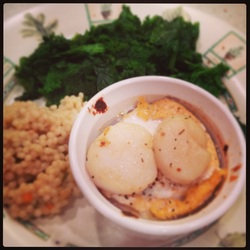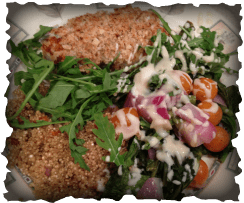Delicate and buttery with a tinge of salty brininess, it’s hard to imagine that scallops were one of the least consumed shellfish in the nineteenth century. Today restaurant menus often feature this luxury food for upwards of $25. But in the past, the lack of scallop offerings was not due to cost, it was simply because they were not as favored. According to James Beard, other varieties of shellfish considered delicacies today were also “underappreciated,” including crab and shrimp.
The most popular nineteenth century shellfish was undoubtedly the much-revered oyster – not only a staple on fine dining tables throughout the Victorian era, but also served up by street vendors in major cities and featured in oyster bars. Lobsters were also a favorite, and even clams, as per the recipes found in era cookbooks.
Charles Ranhofer’s The Epicurean (1893) lists only six recipes for scallops and two for shrimp, but features pages of oyster and lobster dishes, as well as recipes for frogs, snails, and terrapin – the turtle was highly prized at the time. Ranhofer’s comment about scallops: “They are eaten, although of a tough nature.” Perhaps it was the way they were prepared then. Most recipes recommended parboiling prior to frying or baking, which is an unnecessary amount of cooking for these tender morsels. Most modern recipes warn that searing or sautéing scallops a minute or two per side is plenty.
I personally adore scallops, and was delighted when I found dry scallops on sale during a recent trip to the supermarket. Dry scallops taste much better as they are freshly caught. As noted by America’s Test Kitchen’s Molly Birnbaum, wet scallops “are treated with a solution of water and sodium tripolyphosphate, or STPP, which preserves them as soon as they are harvested at sea. Then they're often frozen.” This solution helps preserve them, but it also gives them a spongy texture and imparts a soapy taste.
Because they aren’t wet and soggy, dry scallops are perfect for searing, which is what I did, adapting a 19th century recipe from the era’s celebrity chef, Pierre Blot. Not surprisingly, it was one of just a handful of scallop recipes featured in his cookbooks. As I mentioned, 19th century recipes tended to favor a longer cooking time, and indeed, Blot recommends blanching the scallops first, perhaps to prevent them from sticking to the pan. However, I skipped this step since I wanted to make sure the outside was crispy and the interior remained tender and juicy.
Blot’s recipe is really simple:
Scallops – Blanch the scallops for three minutes, drain them. Put butter on the fire in a frying-pan, and when melted turn the scallops in; stir now and then, take from the fire when fried, add parsley chopped fine, salt, pepper, and serve warm.
Fusing Blot’s recipe with instructions from modern recipes, here’s what I did:
Simply Scallops
I served mine with some linguine dressed in olive oil, lemon, garlic and parlsey alongside some sautéed broccolini (baby broccoli), but feel free to be creative! They were delicious served with a Washington State Pinot Gris.
The most popular nineteenth century shellfish was undoubtedly the much-revered oyster – not only a staple on fine dining tables throughout the Victorian era, but also served up by street vendors in major cities and featured in oyster bars. Lobsters were also a favorite, and even clams, as per the recipes found in era cookbooks.
Charles Ranhofer’s The Epicurean (1893) lists only six recipes for scallops and two for shrimp, but features pages of oyster and lobster dishes, as well as recipes for frogs, snails, and terrapin – the turtle was highly prized at the time. Ranhofer’s comment about scallops: “They are eaten, although of a tough nature.” Perhaps it was the way they were prepared then. Most recipes recommended parboiling prior to frying or baking, which is an unnecessary amount of cooking for these tender morsels. Most modern recipes warn that searing or sautéing scallops a minute or two per side is plenty.
I personally adore scallops, and was delighted when I found dry scallops on sale during a recent trip to the supermarket. Dry scallops taste much better as they are freshly caught. As noted by America’s Test Kitchen’s Molly Birnbaum, wet scallops “are treated with a solution of water and sodium tripolyphosphate, or STPP, which preserves them as soon as they are harvested at sea. Then they're often frozen.” This solution helps preserve them, but it also gives them a spongy texture and imparts a soapy taste.
Because they aren’t wet and soggy, dry scallops are perfect for searing, which is what I did, adapting a 19th century recipe from the era’s celebrity chef, Pierre Blot. Not surprisingly, it was one of just a handful of scallop recipes featured in his cookbooks. As I mentioned, 19th century recipes tended to favor a longer cooking time, and indeed, Blot recommends blanching the scallops first, perhaps to prevent them from sticking to the pan. However, I skipped this step since I wanted to make sure the outside was crispy and the interior remained tender and juicy.
Blot’s recipe is really simple:
Scallops – Blanch the scallops for three minutes, drain them. Put butter on the fire in a frying-pan, and when melted turn the scallops in; stir now and then, take from the fire when fried, add parsley chopped fine, salt, pepper, and serve warm.
Fusing Blot’s recipe with instructions from modern recipes, here’s what I did:
Simply Scallops
- 1 pound dry sea scallops (not bay scallops)
- 1-2 tablespoons butter
- Salt and pepper to taste
- 1-2 tablespoons chopped parsley
- Place scallops in a colander and pat dry with paper towels.
- Melt the butter over very high heat. When pan is sizzling, add scallops and spread out.
- Cook just two minutes a side or until opaque, then remove to a platter and sprinkle with salt, pepper and parsley. That’s it!
I served mine with some linguine dressed in olive oil, lemon, garlic and parlsey alongside some sautéed broccolini (baby broccoli), but feel free to be creative! They were delicious served with a Washington State Pinot Gris.
Sources: Hand-book of Practical Cookery by Pierre Blot, American Cookery by James Beard, The Oxford Companion to American Food and Drink ed. by Andrew F. Smith, The Epicurean by Charles Ranhofer








2 Comments
Sep 24, 2023, 5:24:27 PM
Becky Diamond - Yay! I agree! One of my favorites :)
Sep 22, 2023, 9:32:41 AM
Janice Jarrells - So simple and so delicious. Not dried out, just right.